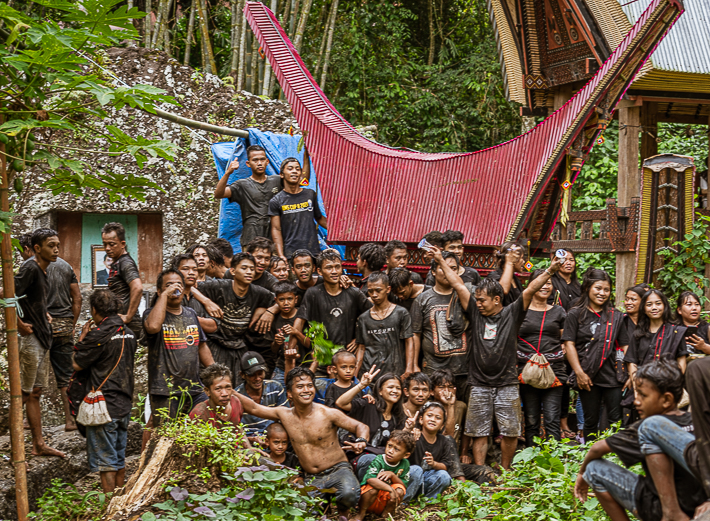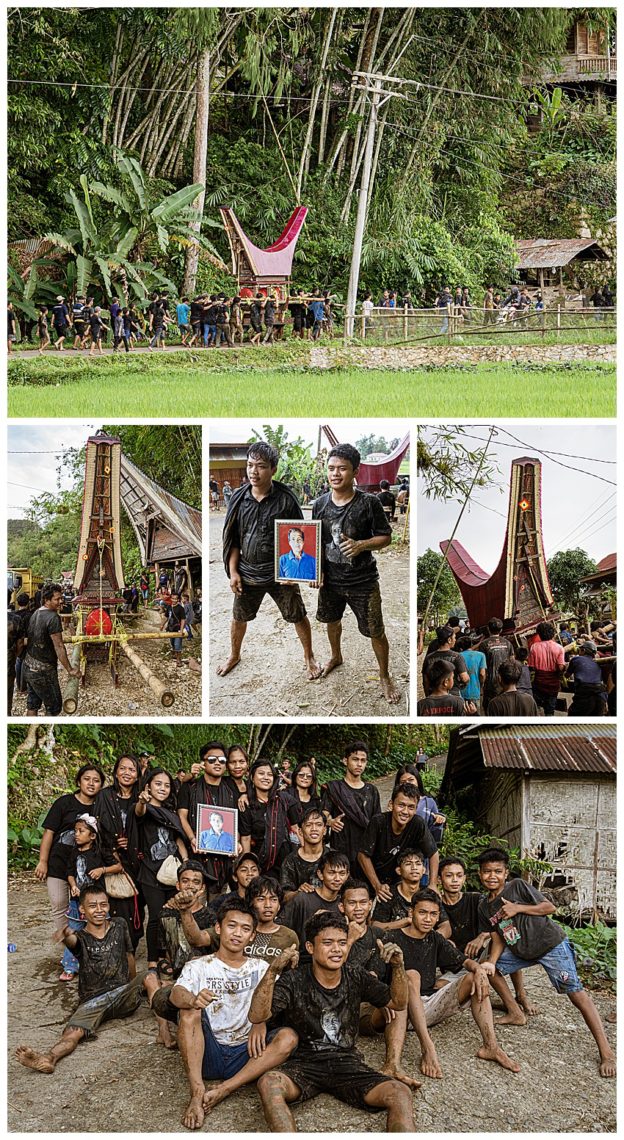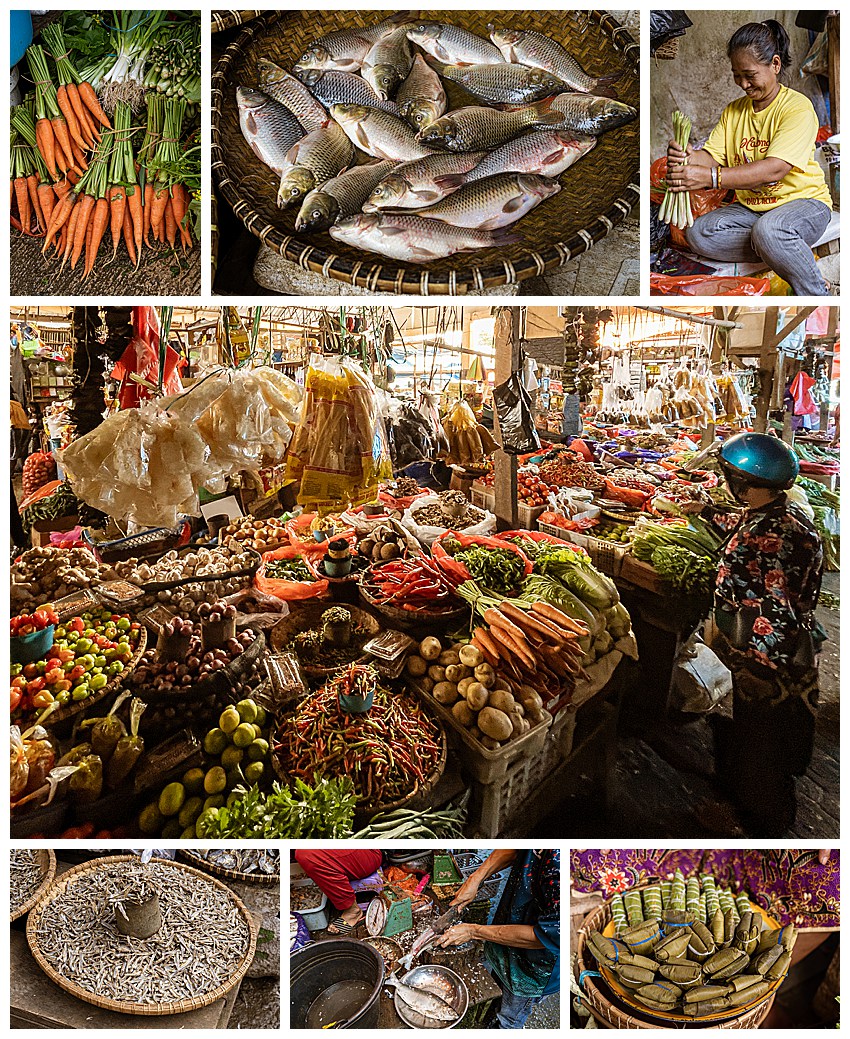
This is the last big party before the spirit of the deceased ascends to heaven in the village of Kandeapi, in Toraja, South Sulawesi. Once the burial is complete, the sprit is finally released. It was a festive occasion, with the friends and family carrying the deceased in the procession from the festival site to the final cave burial site. Those in the march carrying the bola bola seemed like a bunch of wild teenagers having fun, singing and laughing. Several times, it seemed like the coffin would drop, as the coffin was carried up the hill on a bamboo platform. There was a drum beating. There were mud fights, cow pie fights, water fights, boys throwing each other into the rice fields, and dancing. There was not a tear in sight.

We were enroute to another destination, but our van got stopped behind a row of trucks, and we could not see what the holdup was. Sada, our local guide got out to check it out, then came quickly running back, shouting excitedly “they are carrying a coffin to the burial site!” We all clambered out and quickly ran to catch up to the procession (top). This is the finale of the 3-4 day funerals we reported on earlier this week, when the deceased is transported to his final grave site then buried. Sada told us we were really lucky to be able to witness every part of the funeral.
The bola bola carries the deceased in a red mattress-like coffin (center-left). It was rocking and rolling enroute from the temporary festival grounds to the final grave site on the cliff face (center-right). The grandsons carried a picture of their grandfather and posed (center) with their frolicking friends (bottom). Several times the bola bola actually dropped to the ground. The goal of the procession was to wake up the corpse so it would have one last look at the world he is leaving. The procession leads the deceased past the rice fields, the church and his village, before being placed into the final cave burial site. Clearly, everyone was having a good time.

The bola bola (funeral house transport) was brought up to the waiting grave slotted in the cliff wall (upper-left). The body was placed inside the cave, still wrapped in its soft cushion, and then the temporary wooden door was sealed over the hole (upper-right). This wooden door will later be replaced by a permanent seal cover, with a ledge for loved ones to leave food and other offerings in the future.
The bola bola was then moved to a location on the side (top-middle, lower-left and lower-middle), where it will sit until it deteriorates, and/or is replaced by the bola bola from another deceased village member. It was then time to celebrate, so the entire team of mostly teenagers gathered together. While shouting and pumping fists, other family members (and of course, us) took the group photograph (center). After most of the group had dispersed, four of the boys surrounded Evelyn and wanted to see her photos on her camera LCD, since we clearly had more advanced cameras than anyone else there. One of them, Sambo, gave Evelyn his WhatsApp information and asked that we send him the photos and videos (lower-right). We did so a couple days later, and he responded with enthusiastic thanks. Even the grandsons made a point to personally thank us for attending their grandfather’s funeral.
It is believed that you are born into a Torajan boat-shaped house, and leave in the same way, so the architecture of the bola bola is the same style. This was the last day of the 3-4 day funeral. In this funeral for Mr. Marthen Sampe, the deceased was a farmer, and 18 buffalo were sacrificed.
The photos above give some of the flavor of the event, but this 3 minute video really brings it to life. If you are reading this, it is worth the time to watch! Listen for the joy of the funeral procession. Torajans embrace death and celebrate it from the day they are born.

During the funeral season, there are many such funerals happening every day. Our guide said he thought there were at least 6 simultaneous funerals this week, though sometimes there are as many as 20. Indeed, most of the villages we walked or drove through were totally vacant and businesses closed. Everyone had gone to one of these funerals to celebrate the passing of some village member.
With that many funerals happening, it was not unusual to stumble upon one quite by accident. That is what happened with the funeral procession this post opened with above. It is also what happened here, when we came across Day 1 of another funeral. This is the day when the deceased officially transforms from “sick” to “dead” and is brought to the top of a tower to preside over his funeral. This is also the day in which buffalo are sacrificed in his honor — 32 buffalo in this instance.
While we were there, the buffalo were brought in (upper-left), and then gathered on the main common grounds (center). The guests were seated, and then a moderator spoke at length (in Malaysian, so we had no idea what he was saying), and then… nothing…
We learned later that the people were still negotiating how many animals would be sacrificed on which days and what the detailed schedule of events would be. Several of our group had already been seated inside the guest quarters. We decided to move on though, as there was no clear timeframe when the festivities would continue. It is not unusual for schedules to be changed, and even cancelled in some cases. For example, we had been scheduled to attend a different funeral, but one of the guests passed away enroute, so the entire funeral was postponed for an undetermined length of time.

The local market in Toraja was huge. Since we have seen many such markets, we tried to capture the differences. In this market, there were many dried fish, peppers, banana-wrapped products and fish we have not seen in other markets.

Unique to this market were two active chicken production operations. Hordes of live chickens were retrieved from a pen (upper-left), boiled in large hot pots (upper-center), feathers plucked in an automated spinning pot (lower-left), cleaned (upper-right), roasted with propane torches (lower-center), and then cut up for restaurants (lower-right).
The vendors of raw whole chicken vendors very carefully and tastefully placed the heads and feet in an orderly design (center).
The production photos of the prior block barely let you feel what this part of the market was like. Watch this 45 second video better understand the process.